What Is Passion Fruit and How Do You Use It?

Passion fruit, a tropical treasure, offers a unique blend of sweetness and tartness. Encased in a round, wrinkled rind, its vibrant pulp bursts with flavor. Used in various culinary delights, including juices, desserts and cocktails, this fruit is delicious and packed with vitamins, fiber and antioxidants.
If you’re interested in using this fruit and want to know how to incorporate it into your diet, this article is for you! Keep reading to take a closer look at this popular tropical delicacy and answer some common questions, such as “Where does passion fruit grow?” and “What recipes can passion fruit be used in?”
Jump to Section
- What Is Passion Fruit?
- What Does Passion Fruit Taste Like?
- How To Eat Passion Fruit
- Is Passion Fruit Good For You?
- Where To Buy Passion Fruit
What Is Passion Fruit?
Passion fruit, scientifically known as Passiflora edulis, is a tropical fruit that is popular for its sweet yet tart flavor profile and many nutritional benefits. Native to South America, passion fruit features a purple or yellow/orange somewhat wrinkled exterior which houses an orange pulp filled with edible black seeds. The exterior color of the passion fruit depends on the cultivar but the interior filling is similar across all varieties.
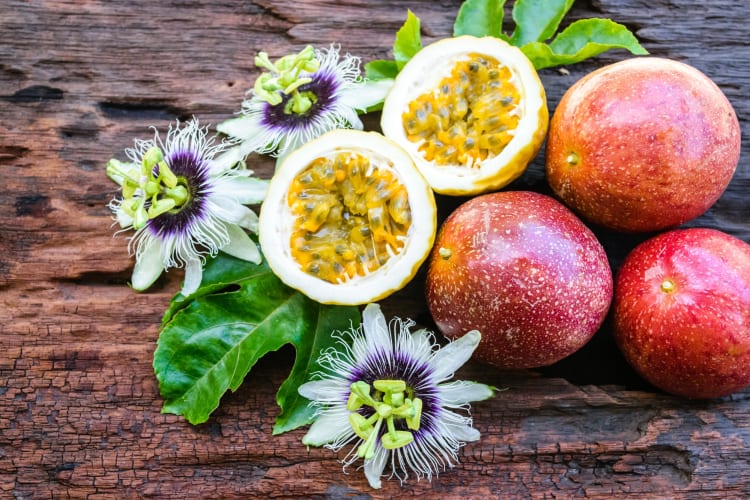
What Does Passion Fruit Look Like?
The fruit is often oval, and, depending on the variety, it can range in size from about the size of a small apple to that of a large egg. Its outer rind is tough and leathery, often wrinkled or dimpled, and can vary in color from deep purple to golden yellow.
When cut open, the passion fruit reveals a cavity filled with aromatic, jelly-like pulp and numerous small, edible seeds. The pulp is typically vibrant yellow or orange, though some varieties may have a more pinkish hue. Its interior is visually striking, with the contrast between the colorful pulp and the dark seeds adding to its appeal.
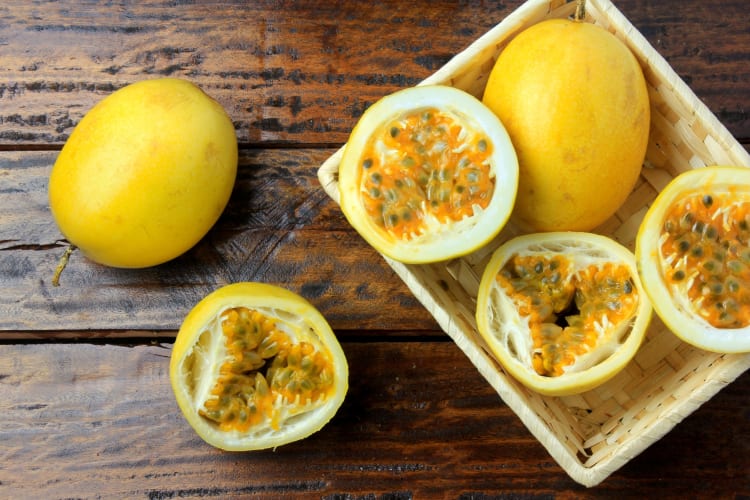
Where Does Passion Fruit Grow?
Passion fruit thrives in warm, tropical and subtropical climates. It is primarily found in its native South America, including countries like Brazil, Ecuador and Colombia. However, passion fruit is now also cultivated in regions worldwide that have similar climate conditions, such as Southeast Asia, Australia, Africa and Hawaii. The vines flourish in well-drained soil with plenty of sunlight, often climbing on trellises or other supports.
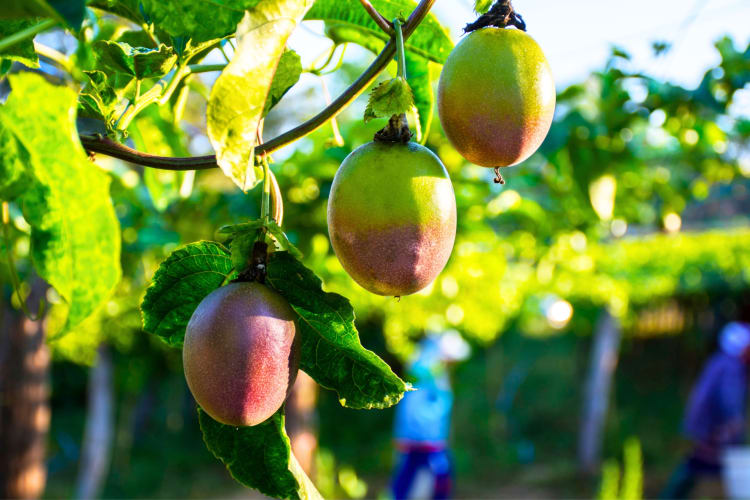
When Is Passion Fruit Season?
Passion fruit vines flourish in warm temperatures, impacting their growing and harvesting season. This fruit can be grown year-round in locations across South America because temperatures remain warm enough for the fruit to thrive throughout the year.
Peak seasons, when the most fruit is harvested, occur during the warmest months, generally in the summer. In subtropical regions, such as parts of Australia and the state of Florida, passion fruit may have a more defined growing season, typically spanning from late spring to early fall when temperatures are warmest.
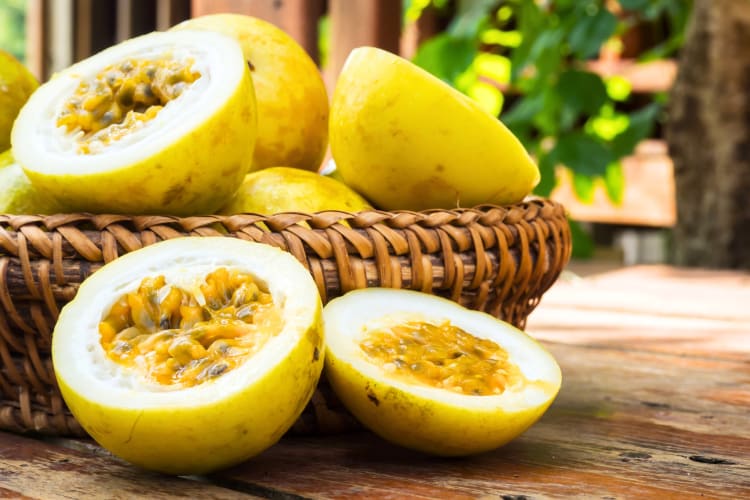
What Does Passion Fruit Taste Like?
The taste of passion fruit is characterized by its unique blend of sweetness and tartness. When you sink your teeth into a ripe passion fruit, your palate is immediately greeted by a burst of tangy acidity reminiscent of citrus fruits like lemon or grapefruit. This tartness is followed by a wave of sweetness similar to the taste of ripe mangoes or pineapple, with floral undertones that add depth to its flavor profile. The juxtaposition of these contrasting flavors creates a complex and delightful taste sensation that is very refreshing.
But what does a passion fruit taste like compared to other fruits? While it shares some similarities with citrus fruits in its tartness, it also possesses a distinct sweetness that sets it apart. Unlike the intense sweetness of fruits like strawberries or bananas, the sweetness of passion fruit is more subtle and nuanced, with a delicate floral quality that adds complexity to its flavor. Additionally, the texture of the passion fruit pulp, with its crunchy seeds and jelly-like consistency, contributes to a unique eating experience.
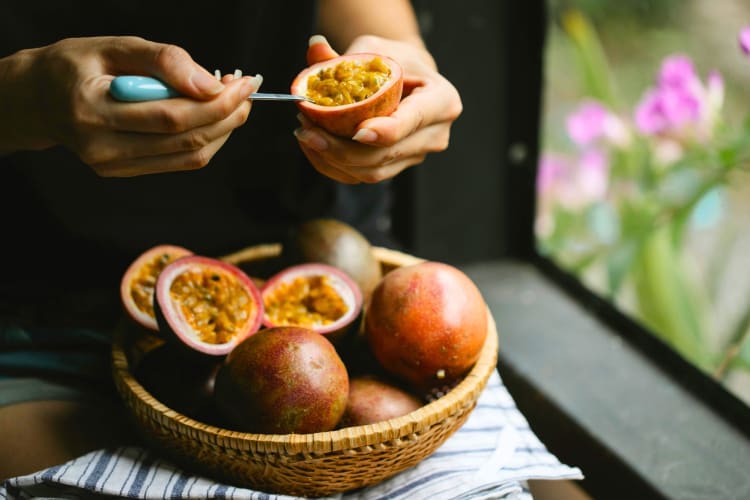
How To Eat Passion Fruit
Passion fruit is a versatile fruit that is easy to prepare and enjoy. You can eat it raw, consuming the seeds or taking them out. You can also use passion fruit to make juice or add it to your favorite dessert recipes. For a simple recipe, add passion fruit pulp on top of your favorite ice cream or sorbet. Another great use for passion fruit is adding it to cocktails or mocktails, such as a delicious passion fruit mojito.
Still unsure how to best incorporate passion fruit into your recipes? Consider taking some cooking classes near you or a fun online cooking class that focuses on desserts and other recipes that incorporate tropical fruits. If you want to focus on making passion fruit drinks, sign up for online mixology classes that teach you how to make fruit-filled cocktails and mocktails.

How To Cut Passion Fruit
Passion fruit is relatively easy to cut. Simply place the fruit on a cutting board and hold it firmly with one hand. Using a sharp knife, carefully slice the passion fruit in half lengthwise. Apply gentle pressure to pierce through the tough outer rind.
Once the fruit is halved, you will see the vibrant pulp and seeds inside. To extract the pulp, use a spoon to scoop it out from the rind, sliding it along the inner edge to loosen it. Repeat the process for the other half of the passion fruit. Once the pulp is removed, discard the empty rinds.
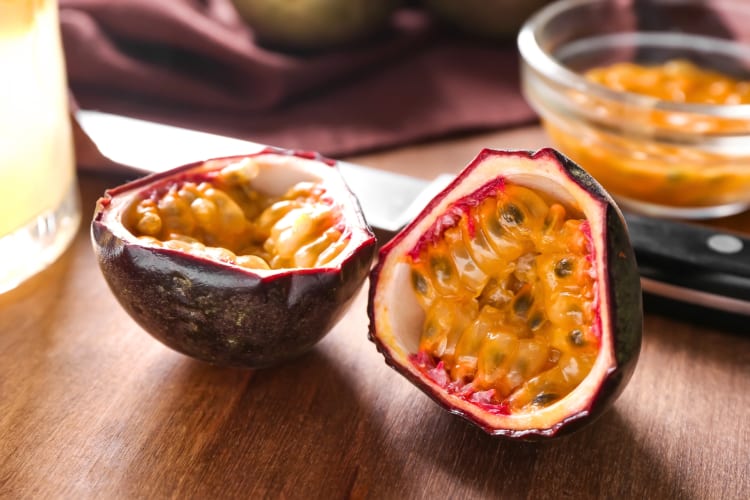
How To Make Passion Fruit Juice
One popular way to enjoy passion fruit is as a juice. While you can purchase pre-made passion fruit juice in many stores, enjoying it fresh is always best.
Here are some simple instructions for making refreshing passion fruit juice at home:
- Wash the passion fruit before cutting each passion fruit in half lengthwise using a sharp knife.
- Scoop out the pulp by holding each passion fruit half over a bowl and using a spoon to scoop out the pulp and seeds. Place the pulp and seeds into the bowl, collecting as much as possible. If you don’t want the seeds in your juice, run the pulp and seed mixture through a stainer to separate.
- Blend the pulp and seeds (if using them) in a blender. Pulse the blender a few times to break up the pulp and seeds and release the juice.
- Strain the juice by placing the blended mixture into a fine mesh strainer or cheesecloth draped over a bowl. Pour the mixture through the strainer. You can use the back of a spoon to press down on the pulp and extract as much juice as possible. Discard the remaining pulp and seeds.
- Chill, serve and enjoy!
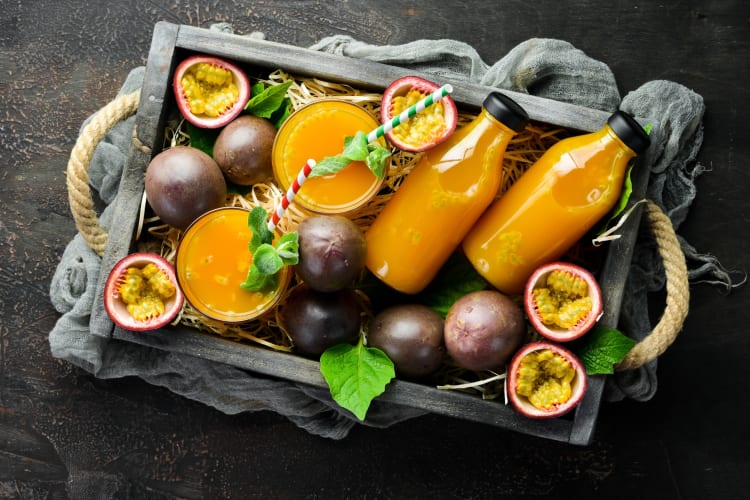
When Are Passion Fruit Ripe and Ready To Use?
Eating passion fruit is a delightful experience that begins with selecting a ripe fruit. If you wonder how to tell if a passion fruit is ripe before using it in a recipe, look for wrinkled skin, indicating ripeness. Ripe passion fruits are usually vibrantly and uniformly colored, have a rich and aromatic scent, feel slightly heavy for their size and yield to gentle pressure when squeezed.
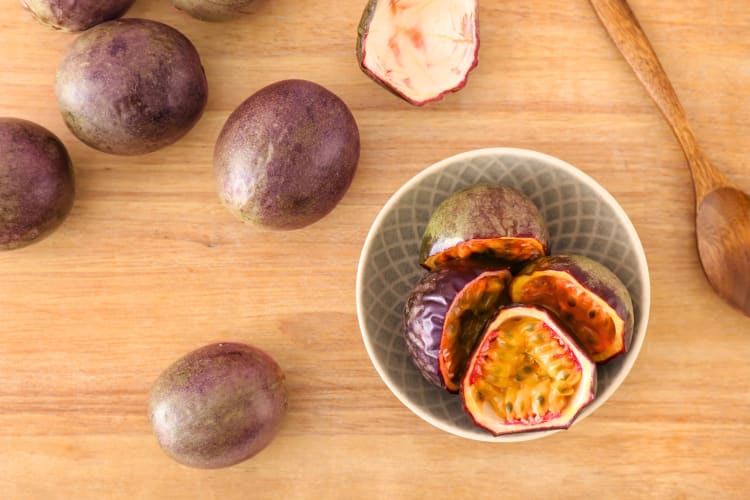
Can You Eat Passion Fruit Seeds?
Many people ask the question: “Are passion fruit seeds edible?” The answer is yes. While the texture may be slightly crunchy, they are safe to eat and are often consumed along with the juicy pulp of the fruit. Some ways to enjoy passion fruit seeds include as a yogurt or oatmeal topping, in smoothies or on their own as a crunchy treat. You can also discover ways to muddle passion fruit seeds into cocktails.
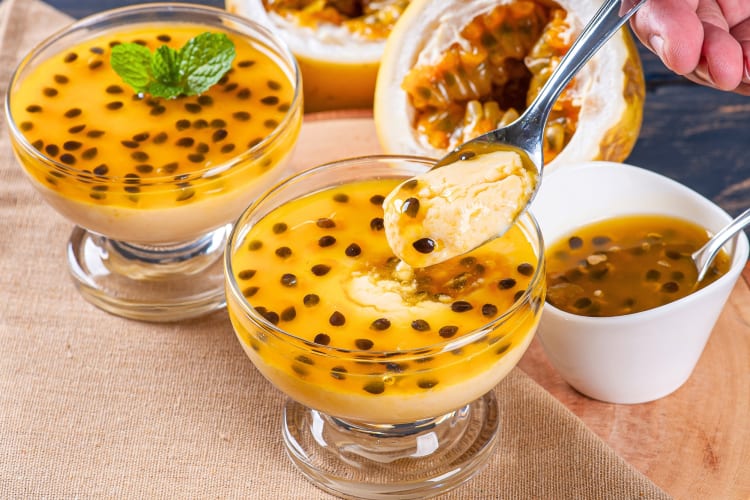
Is Passion Fruit Good For You?
The health benefits of passion fruit, from its vitamin content to its antioxidants, are abundant. Rich in vitamins, particularly vitamin C and vitamin A, passion fruit contributes to healthy immune function, collagen production and overall skin health.
Additionally, it contains dietary fiber, which aids digestion and promotes gut health. To get the most fiber per serving, consume the seeds along with the pulp. The fruit also provides antioxidants, such as carotenoids and polyphenols, which may help combat oxidative stress and reduce the risk of heart disease and cancer.
All these nutritional benefits sound appealing, but is passion fruit good for health? While it is low in calories and fat, it does contain natural sugars, so individuals with diabetes or those who are otherwise watching their sugar intake should be mindful of portion sizes. Furthermore, passion fruit seeds may pose a choking hazard for young children or individuals with swallowing difficulties. It is important to consult your doctor if you have any questions or concerns about how to start eating healthy or the safety of including this tropical fruit in your diet.
For most people, however, consuming passion fruit in moderation is excellent for health. The sugars in the fruit are also natural, which are generally not a health concern unless consumed in very large quantities.
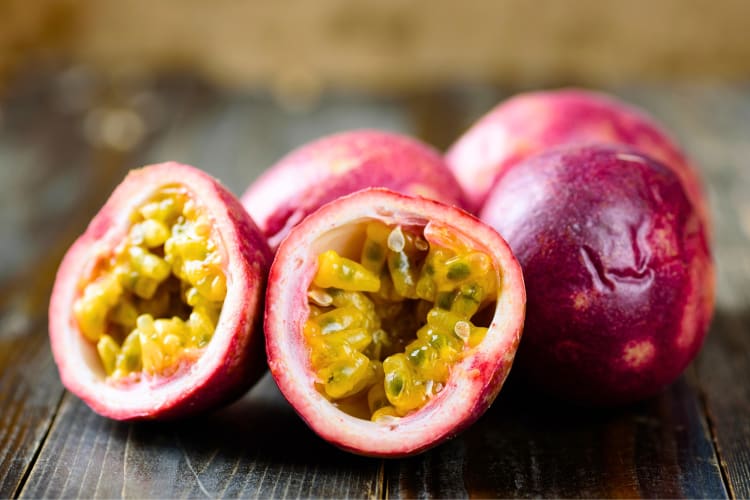
Where To Buy Passion Fruit
Passion fruit is relatively easy to find and can be purchased in many well-stocked grocery stores, especially those that carry a wide variety of fruits. Look for it in the produce section, where it may be sold individually or in bulk alongside other exotic fruits. Additionally, specialty markets or international grocery stores, particularly those catering to Latin American or Southeast Asian cuisines, will likely carry this popular tropical fruit.
If you live in a tropical or subtropical area, farmers markets are another great place to find fresh passion fruit when it's in season. They often offer locally grown varieties with exceptional flavor. If the vendor happens to grow passion fruit, also ask them for some recipe suggestions.
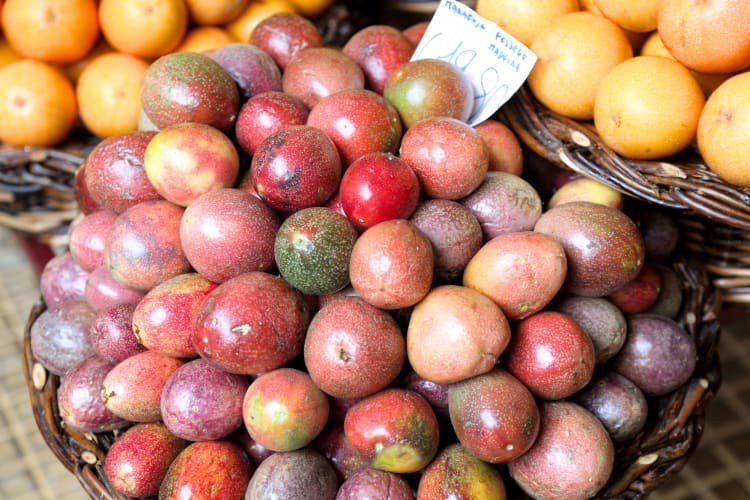
Passion fruit is a flavorful tropical delight and a nutritious addition to your diet. Its unique blend of sweetness and tartness and versatility in culinary applications make it a popular fruit worldwide. Whether enjoyed fresh, blended into smoothies, used in recipes or as a garnish for cocktails, passion fruit offers a refreshing taste of the tropics.
If you’ve been wanting to answer the question: “What is passion fruit and how do I use it?” this article should have told you everything you need to know. So, next time you come across this exotic fruit, be sure to try it. You will reap its numerous health benefits and tantalize your taste buds!
For even more ways to explore your favorite foods, check out other experiences happening on Cozymeal.
